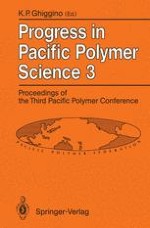1994 | OriginalPaper | Chapter
Polymer Design for Minimally Adhesive Surfaces
Authors : K. J. Wynne, T. Ho, R. A. Nissan, X. Chen, J. A. Gardella Jr.
Published in: Progress in Pacific Polymer Science 3
Publisher: Springer Berlin Heidelberg
Included in: Professional Book Archive
Activate our intelligent search to find suitable subject content or patents.
Select sections of text to find matching patents with Artificial Intelligence. powered by
Select sections of text to find additional relevant content using AI-assisted search. powered by
In connection with our interest in the development of minimally adhesive surfaces to discourage the settlement of marine organisms, we have investigated polyurethanes and polyureas containing polydimethylsiloxane (PDMS) segments. A two-step polymerization method was used to prepare dimethylsiloxane-urea-urethane copolymers with 1,4-benzenedimethanol as the chain extender. Thermal and mechanical properties of copolymers with chain extenders were found to be superior to those without chain extender, due to the additional hydrogen bonding interactions for the former. Surface composition was determined by angle-dependent electron spectroscopy for chemical analysis (ESCA). Effects of segmental length and annealing on the surface composition were investigated. One of the siloxane containing copolymers was used as the minor component (1.6, 2.5 and 6.0 wt %) in a series of blends with a poly(ether-urethane), which preserved the mechanical properties of the poly(ether-urethane) as well as the surface properties of the poly(siloxane-urea-urethane).
